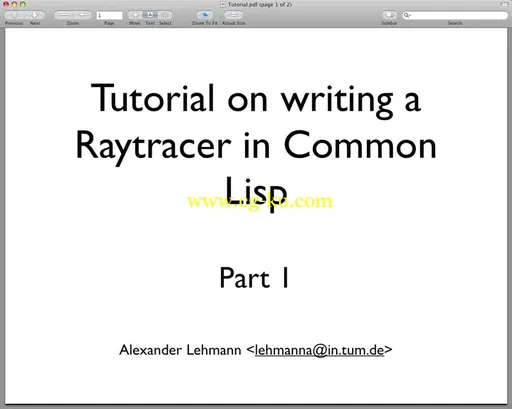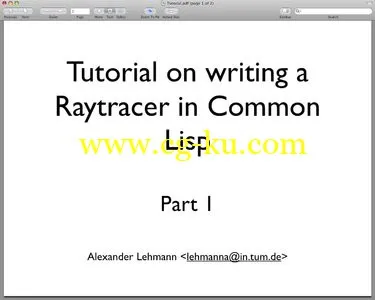
Alexander Lehmann - Writing a simple raytracer in Common Lisp | 750MB
Duration: 3.5 hours | Video: AVC 187Kbps 1280x1024 10Kfps | Audio: ADPCM 93.7Kbps, 22.05KHz, 2 channels
Released: 2008 | Genre: eLearning | Level: Beginner | Language: English
After stumbling upon Marco Baringer's and Rainer Joswig's Lisp related screencasts I realized how interesting, helpful and informative their contributions have been to me (thanks a lot!) and hence considered creating a comprehensive screencast/tutorial myself.
As I think that screencasts are a great idea to give someone a first insight into a particular topic and because (recently) on reddit there's been lots of discussions about Lisp being only for quantum physicists and the like, I eventually decided to create a tutorial on writing a simple raytracer in Common Lisp.
In my humble opinion, writing a raytracer shouldn't be too sophisticated for novices but allows for unveiling a reasonable amount of the programming language. And as far a the relatively easy mathematics and in particular the background of raytracing are concerned, I have included explanatory slides which will be thoroughly discussed during the tutorial.
Unfortunately I have only very limited time and hence couldn't finish each and everything that I would have liked to see in the tutorial. At the end of the provided screencasts, however, the raytracer is at a stage where basic raytracing and lighting do work.
As the creation of the screencasts and slides really was a lot of work and as I do not claim to be a Lisp uber-professional, I'd of course like to hear from you yet also ask you in advance to forgive me my (lispy) mistakes. The ones that I know about have been mentioned in the subsequent movie respectively. Also, please note that the first part is a neccessary prerequisite to its successors, yet the more interesting stuff starts from Part 2.
Content
Part 1 - Linear Algebra
Part 2.1.0 - Basic Raytracing
Part 2.1.1 - Basic Raytracing
Part 2.1.2 - Basic Raytracing

发布日期: 2014-08-19